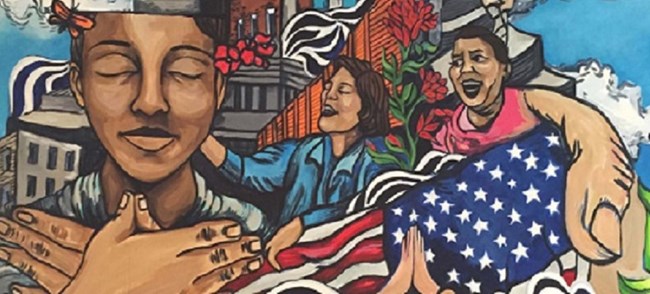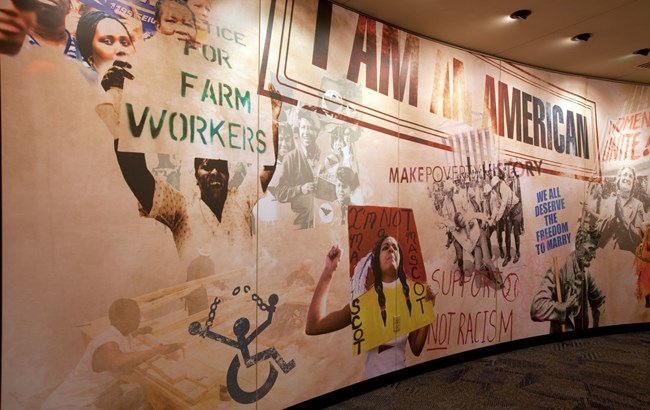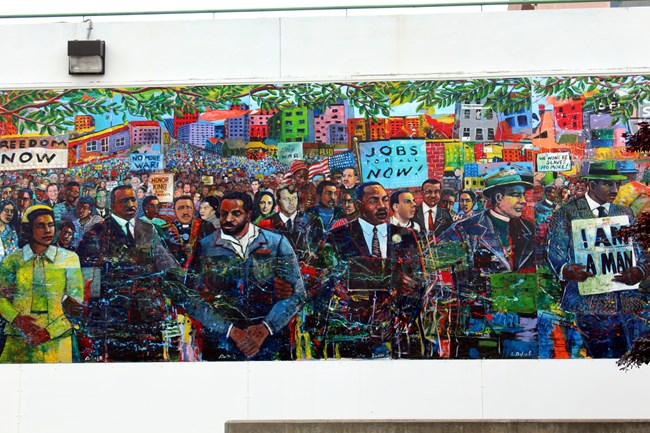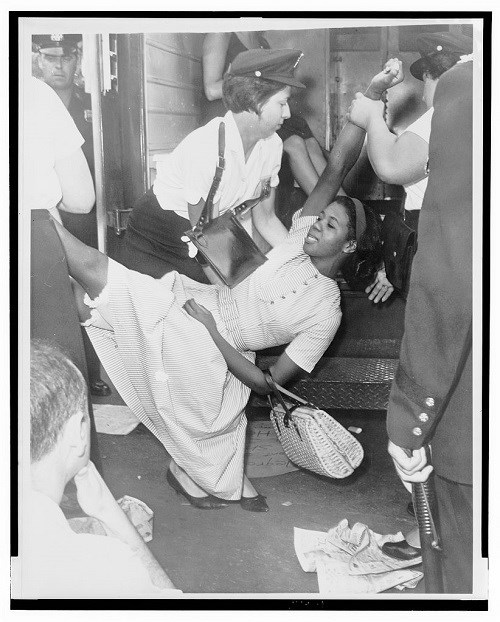Last updated: February 14, 2025
Article
Pathways Through American History: Making a Democracy

https://www.nps.gov/media/photo/view.htm?id=23BE4261-155D-451F-677D45EBFC665D34
A More Perfect Union
This Pathway, "Making A Democracy," highlights how people fought to access and expand civil and political rights, as well as how others have reacted to and resisted their efforts.

Courtesy Library of Congress
Marker 1 of 4: How did people exercise their First Amendment rights to make their voices heard?
The First Amendment to the Constitution guarantees the freedoms of speech, press, religion, assembly, and petition. Discover how some activists spoke out against inequality and advocated for rights expansions by exercising these rights.
When have you needed courage to use your voice? What do you need from history to draw attention to a cause you care about?
Speaking Out
-
 Curiosity KitMary Ann Shadd Cary
Curiosity KitMary Ann Shadd CaryAs a skilled speaker and journalist, Cary used the press and her voice to advocate for abolition & voting rights for Black Americans.
-
 ArticleMarsha P. Johnson & Sylvia Rivera
ArticleMarsha P. Johnson & Sylvia RiveraTrans activists Johnson & Rivera took to the streets during and after the Stonewall Uprisings to advance LGB liberation.
-
 ArticleNWP Protests During WWI
ArticleNWP Protests During WWIDuring World War I, members of the National Woman's Party picketed the White House to demand women's suffrage, facing violence and arrest.
More to Explore
Below, you’ll find even more histories about how activists joined ranks and made their voices heard by exercising their First Amendment freedoms.
Places of Zitkála-Šá
Zitkála-Šá was a Yankton Sioux writer, musician, & lecturer who fought for Native American citizenship & women's equality.
Frederick Douglass
Due to his talents as a speaker and writer, Douglass captivated the public with autobiographical accounts of his experiences while enslaved.
The 19th Amendment, Elizabeth Peratrovich, and the Ongoing Fight for Equal Rights
Peratrovich led the charge to end discrimination against Alaska Natives, who paid taxes & fought wars for the US but lacked equal rights.
Curiosity Kit: Mabel Ping-Hua Lee
As a Chinese immigrant and woman, Lee couldn't vote in 1912. She joined suffrage parades to advance women's education, independence, and vote.
Yuri Kochiyama
Experiencing Japanese incarceration inspired Kochiyama to protest injustice and pursue the liberation and empowerment of people of color.

Photo by Wally Gobetz, 2013
Marker 2 of 4: How is the fight for voting rights related to other civil rights struggles?
Battles for the ballot are often linked to other struggles for freedom, equality, and political recognition. Discover how the fight for voting rights relates to other aspects of the Black freedom struggle.
How can you make what matters to you about more than just yourself? What do you need from history to inspire others to join you?
Fighting for the Vote
-
 ArticleCivil Rights: Whose Voice is Heard?
ArticleCivil Rights: Whose Voice is Heard?In the United States, people have long fought to have their voices heard. One way of doing this is through voting.
-
 Article SeriesThe Antislavery Movement & Voting Rights
Article SeriesThe Antislavery Movement & Voting RightsThe 15th & 19th Amendments moved the US closer to its ideals, but the fight against racism & sexism began much earlier.
-
 ArticleBlack Women Fight for Voting Rights
ArticleBlack Women Fight for Voting RightsDespite Black women's active role fighting for suffrage, Black men & white women often excluded them from organizations & activities.
More to Explore
The Modern Civil Rights Movement is one of several civil rights struggles that occurred during the 1900s. The histories below illustrate how different groups approached the fight for civil rights with inspiration from the tactics, messages, and leaders of other movements.
Asian American Activism and Civic Participation: Battling for Political Rights and Citizenship, 1917 to the Present
AAPI battles for equality span from inclusion in political & judicial processes to grassroots efforts to reform living & working conditions.
American Latino Theme Study: Struggles for Inclusion
This essay focuses on efforts by various American Latino groups for full political & civic inclusion as citizens of the US.
LGB Civil Rights in America
This chapter explores battles for LGB civil rights & touches on the role of LGB Americans in other civil rights struggles.
Disability History: The Disability Rights Movement
Since the 1900s, treatment & perceptions of disability have transformed because people with disabilities demanded & created those changes.

World Telegram & Sun photo by Dick DeMarsico, courtesy Library of Congress.
Marker 3 of 4: What kind of challenges did activists encounter when they fought for rights expansions? How can conflict lead to change?
Voting rights and civil rights activists encountered many different obstacles in the struggle for equality. Discover some of the internal disagreements, ideological challenges, and violent backlash that they experienced.
How does democracy make room for disagreement? What do you need from history to respect opinions and ideas that are different than yours?
Overcoming Obstacles
-
 ArticleAnti-Suffragism in the United States
ArticleAnti-Suffragism in the United StatesAlthough anti-suffragists eventually lost their battle, their opposition delayed women’s suffrage for decades.
-
 (H)our History LessonSelma to Montgomery Voting Rights March
(H)our History LessonSelma to Montgomery Voting Rights MarchThis lesson analyzes the roles played by local activists and national organizations in the voting rights campaign in Selma, Alabama.
-
 ArticleAlice Paul vs. Carrie Chapman Catt
ArticleAlice Paul vs. Carrie Chapman CattAlthough Paul & Catt both fought for women's suffrage, they often fought each other as they worked for passage of the 19th Amendment.
More to Explore
These resources chronicle even more ways that activists turned obstacles into opportunities to advance their respective causes.
Fighting for Suffrage: Comrades in Conflict
The struggle for voting rights involved a split between abolitionist Frederick Douglass and Susan B. Anthony and Elizabeth Cady Stanton.
Democracy Limited: The Suffrage "Prison Special" Tour of 1919
This series explores how the “Prison Special” aided the cause of women’s suffrage & helped secure the ratification of the 19th Amendment.
The "Sip-In" at Julius' Bar in 1966
Inspired by sit-ins in the American South, discover how the LGB community challenged New York's "drinking while gay" legal restrictions.

Photo by Carol Highsmith, courtesy Library of Congress.
Marker 4 of 4: How are civil and political rights contested?
One of the goals of the U.S. Constitution is to “form a more perfect union” that protects the rights and liberties of the American people. The resources below consider how the fight for equal rights is ongoing and incremental.
What do you need from history to ensure the United States lives up to its promise?
Keeping Up the Fight
-
 ArticleWho Was Excluded?: Women's Suffrage
ArticleWho Was Excluded?: Women's SuffrageNot all women shared the same freedom to vote after the passage of the 19th Amendment. Women of color were often kept from the polls.
-
 ArticleVoting Rights: What's Next?
ArticleVoting Rights: What's Next?Progress is rarely steady & comes about in fits & starts. Learn about the fight for voting rights after the passage of the 19th Amendment.
-
 (H)our History Lesson SeriesTeaching Engaged Citizenship
(H)our History Lesson SeriesTeaching Engaged CitizenshipThese lessons consider how engaged citizens tackled historical challenges & how these tactics compare to current struggles.
Keep Up the Pace
American democracy functions best when everyone’s voices are heard.
Get Off the Beaten Path
The content for this article was researched and written by Jade Ryerson, an intern with the Cultural Resources Office of Interpretation and Education.
